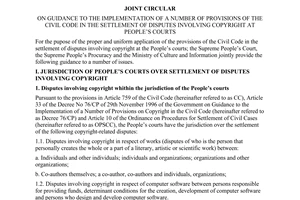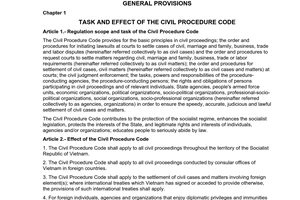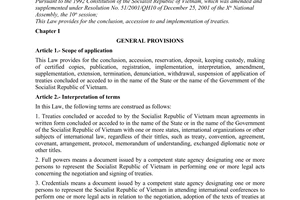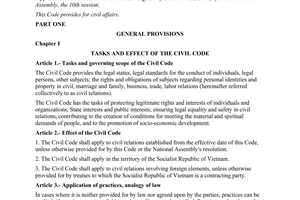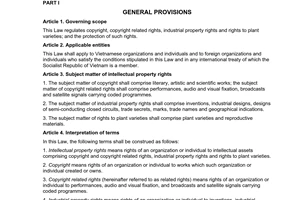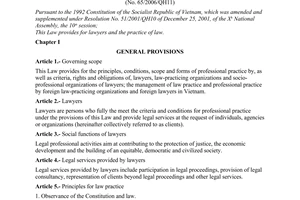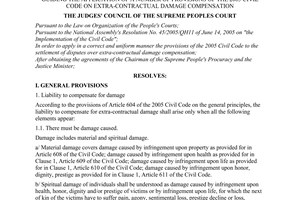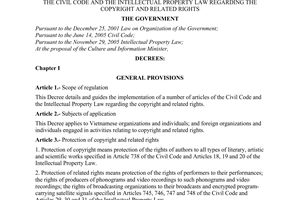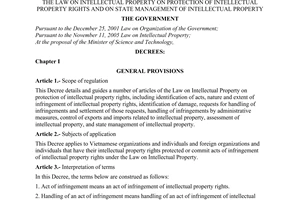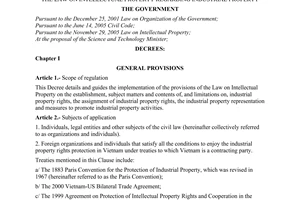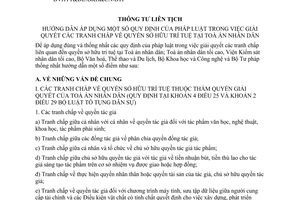Nội dung toàn văn Joint Circular No. 02/2008/TTLT-TANDTC-VKSNDTC-BVHTT&DL-BKH&CN-BTP of April 3, 2008, guiding the application of a number of legal provisions to the settlement of disputes over intellectual property rights at People’s Courts.
|
THE SUPREME
PEOPLES COURT |
SOCIALIST
REPUBLIC OF VIET NAM |
|
No. 02/2008/TTLT-TANDTC-VKSNDTC-BVHTT&DL-BKH&CN-BTP |
Hanoi, April 3, 2008 |
JOINT CIRCULAR
GUIDING THE APPLICATION OF A NUMBER OF LEGAL PROVISIONS TO THE SETTLEMENT OF DISPUTES OVER INTELLECTUAL PROPERTY RIGHTS AT PEOPLES COURTS
In order to properly and uniformly apply legal provisions to the settlement of disputes over intellectual property rights at peoples courts, the Supreme Peoples Court, the Supreme Peoples Procuracy, the Ministry of Culture, Sports and Tourism, the Ministry of Science and Environment and the Ministry of Justice jointly provide the following guidance:
A. GENERAL MATTERS
I. DISPUTES OVER INTELLECTUAL PROPERTY RIGHTS WHICH FALL UNDER THE HANDLING COMPETENCE OF PEOPLES COURTS (SPECIFIED IN CLAUSE 4, ARTICLE 25 AND CLAUSE 2, ARTICLE 29 OF THE CIVIL PROCEDURE CODE)
1. Disputes over copyright
a/ Disputes among individuals over copyright to literature, artistic or scientific works or derivative works;
b/ Disputes among co-authors over division of the co-authorship right;
c/ Disputes between individuals and organizations over the ownership of copyright to works;
d/ Disputes between copyright owners and authors over royalties or remunerations for authors who have created works under task assignments or contracts;
e/ Disputes over the exercise of moral rights or economic rights of authors or copyright owners;
f/ Disputes over copyright to computer programs or data compilations between entities that provide finance and physical conditions decisive to the development of computer programs or data compilations and designers and developers of these computer programs or data compilations;
g/ Disputers over copyright to cinematographic or dramatic works between entities that invest finance and material-technical facilities in the production of these works and persons who participate in the creation of these works and producers of these works, or disputes between them over royalties, remunerations and other material benefits;
h/ Disputes between copyright owners and users of published works that are not required to ask for authority or pay royalties or remunerations for the reason that such use affects the normal utilization of these works or causes harms to rights of work authors or copyright owners;
i/ Disputes between copyright owners and users of published works that are not required to ask for authority but are obliged to pay royalties or remunerations for the reason that the users fail to pay royalties or remunerations or affect the normal utilization of these works or cause harms to rights of work authors or copyright owners;
j/ Disputes over contracts on copyright assignment or licensing, or disputes over contracts on copyright service;
k/ Disputes arising from acts of infringing upon copyright;
l/ Disputes over succession or inheritance of economic rights as specified in Article 20 and moral rights as specified in Clause 3, Article 19 of the Intellectual Property Law.
m/ Other disputes over copyright as specified by law.
2. Disputes over related rights
a/ Disputes between investors and performers over moral rights and economic rights to performances; disputes between performers and users of economic rights to performances over remunerations;
b/ Disputes between producers of phonograms or video recordings and entities exercising rights of producers of phonograms or video recordings over material benefits from public distribution of these phonograms or video recordings;
c/ Disputes between broadcasting organizations and users of rights of broadcasting organizations over material benefits from audio or video recording or public distribution of these organizations broadcasts;
d/ Disputes between performers, producers of phonograms or video recordings or broadcasting organizations and entities exercising related rights that are not required to ask for authority or pay royalties or remunerations for the reason that the use of these performances, phonograms, video recordings or broadcasts affects their normal utilization and cause harms to rights of performers, producers of phonograms or video recordings or broadcasting organizations:
e/ Disputes between authors, copyright owners, performers, producers of phonograms or video recordings or broadcasting organizations and users of related rights that are not required to ask for authority but are obliged to pay royalties or remunerations for the reason that users are not required to pay royalties or remunerations or the use affects the normal utilization of performances, phonograms, video recordings, broadcasts and causes harms to rights of performers, producers of phonograms or video recordings or broadcasting organizations;
f/ Disputes over related rights to performances, phonograms, video recordings or broadcasts (who are owners of these performances, phonograms, video recordings or broadcasts);
g/ Disputes arising from acts of infringing upon related rights;
h/ Disputes over succession or inheritance of related rights;
i/ Other disputers over related rights as specified by law.
3. Disputes over industrial property rights
a/ Disputes over the right to register inventions, industrial designs, layout designs, marks or geographical indications;
b/ Disputes over the priority right to applications for registration of inventions, industrial designs or marks;
c/ Disputes over author rights to inventions, industrial designs or layout designs;
d/ Disputes over moral rights or economic rights of authors of inventions, industrial designs or layout designs;
e/ Disputes over temporary rights to inventions, industrial designs or layout designs between entities having the right to file applications for registration of inventions, industrial designs or layout designs and entities currently using these industrial property objects, or disputes over compensations between holders of protection titles and users of inventions, industrial designs or layout designs:
f/ Disputes over the right to prior use of inventions or industrial designs between owners of these inventions or industrial designs and prior users of these inventions or industrial designs related to the transfer of such right to other entities, expansion of the use scope or volume without authority of owners of these industrial property objects;
g/ Disputes over compensations between holders of protection titles of inventions, industrial designs or layout designs and users of these inventions, industrial designs or layout designs during the period from the date of publication of protection title applications on the Industrial Property Official Gazette to the date of grant of protection titles;
h/ Disputes over rights of owners of industrial property objects (including disputes over right portions of co-owners);
i/ Disputes arising from infringements of industrial property rights;
j/ Disputes arising from infringements of rights of authors of inventions, industrial designs or layout designs;
k/ Disputes over remunerations paid to authors of inventions, industrial designs or layout designs;
l/ Disputes over contracts on assignment of industrial property rights or contracts on licensing of industrial property objects; or disputes over contracts on industrial property representation services:
m/ Disputes over succession or inheritance of industrial property rights, economic rights of authors of inventions, industrial designs or layout designs;
n/ Disputes arising from acts of unfair competition;
o/ Other disputes over industrial property rights as specified by law.
II. RIGHT TO INSTITUTE CIVIL LAWSUITS ON INTELLECTUAL PROPERTY RIGHTS
1. Right to institute civil lawsuits over copyright or related rights
a/ Individuals and organizations defined in Article 14 of the Governments Decree No. 100/2006/ND-CP of September 21, 2006, detailing and guiding the implementation of a number of articles of the Civil Code and the Intellectual Property Law on copyright and related rights (below referred to as Decree No. 100/2006/ND-CP for short) may institute civil lawsuits over copyright or related rights at competent peoples courts for protection of their rights and lawful interests.
b/ Concerned state agencies and organizations may, within the scope of their tasks and powers, institute civil lawsuits to protect public interests and the States interests in the domain of copyright and related rights according to Clause 3, Article 162 of the Civil Procedure Code and the guidance in Item 2.1, Section 2, Part I of Resolution No. 02/2006/NQ-KDTP of May 12, 2006, of the Judges Council of the Supreme Peoples Court, guiding the implementation of the provisions of the Civil Procedure Codes Part Two on Procedures for Handling Cases at First-Instance Courts.
2. Right to institute civil lawsuits over industrial property rights belongs to:
a/ Individuals and organizations involved in disputes over the right to register inventions, industrial designs, layout designs, marks or geographical indications;
b/ Authors or co-authors of inventions, industrial designs, layout designs;
c/ Holders of protection titles of inventions, industrial designs, layout designs;
d/ Holders of certificates of registered or internationally registered marks, which are accepted for protection in Vietnam, owners of well known marks;
e/ Holders of industrial property rights to business secrets or trade names;
f/ Individuals and organizations having the lawful right to use geographical indications, organizations or collectives representing individuals and organizations empowered to use geographical indications;
g/ Organizations and individuals possessing industrial property objects involved in acts of unfair competition in the domain of industrial property;
h/ Lawful heirs of authors of inventions, industrial designs or layout designs; or lawful heirs or heirs of industrial property rights of owners of industrial property objects;
il Individuals and organizations that are lawfully assigned the ownership of industrial property objects;
jl Individuals and organizations that are lawfully licensed to use industrial property objects;
k/ Individuals and organizations that are licensed to use industrial property objects under decisions of competent state agencies:
l/ Other rights holders as defined by law.
III. CONDITIONS ON INSTITUTION OF CIVIL LAWSUITS OVER INTELLECTUAL PROPERTY RIGHTS
1. Conditions on institution of a civil lawsuit over copyright or related rights
a/ The copyright and related rights have been established under Clauses 1 and 2, Article 6 of the Intellectual Property Law.
The author, copyright holder or related rights holder may file an application for a registration certificate of copyright or related rights under Article 49 of the Intellectual Property Law. However, this is not a compulsory procedure for enjoyment of copyright or related rights.
If parties involved in a dispute over copyright or related rights institute a lawsuit to request a court to protect their lawful rights and interests, the court shall consider the case regardless of whether or not they have registration certificates of copyright or related rights or whether or not they have filed applications for registration of copyright or related rights.
b/ The duration of protection of copyright or related rights has not expired under the law on intellectual property.
The author, copyright holder and related rights holder may only exercise their moral rights and economic rights within the scope and in the duration prescribed by the law on intellectual property.
The duration of protection of copyright or related rights is specified in Clauses 2 and 3, Article 739 of the 2005 Civil Code, Articles 27 and 34 of the Intellectual Property Law and Article 26 of Decree No. 100/2006/ND-CP.
Upon the expiration of the duration of protection of copyright or related rights under the above provisions (except for moral rights specified in Clauses 1, 2 and 4, Article 19 of the Intellectual Property Law), rights of the author, copyright holder and related rights holder will no longer be protected by the State and the law. Unless the law specifies no protection duration for copyright, the court shall accept lawsuit petitions for handling only in case these rights are still in the protection duration.
2. Conditions on institution of a civil lawsuit over industrial property rights
2.1. Industrial property rights have been established on the grounds specified in Clause 3, Article 6 of the Intellectual Property Law and -Article of the Governments Decree No. 103/2006/ND-CP of September 22, 2006, detailing and guiding the implementation of a number of articles of the Intellectual Property Law on industrial property (below referred to as Decree No. 103/2006/ND-CP for short).
It is necessary to clearly identify industrial property object(s) (invention, industrial design, layout design or mark) being the subject matter of the dispute in order to determine the grounds for the establishment of industrial property rights to such object(s) because grounds for the establishment of industrial property rights to an industrial property object are not the same in any circumstances and the registration procedure is required in some cases but not in other cases. For example, industrial property rights to a mark are established under a decision of the National Office of Intellectual Property (the Ministry of Science and Technology) on the grant of a protection title under the registration procedure specified in the Intellectual Property Law and other relevant legal documents, or on the recognition of an international registration under a treaty to which the Socialist Republic of Vietnam is a contracting party. Particularly, industrial property rights to a well known mark can be established on the basis of the wide and practical use of that mark and the criteria specified in Article 75 of the Intellectual Property Law without having to pass the registration procedure.
For a dispute over industrial property rights to an industrial property object and it is necessary to ascertain whether or not these industrial property rights have been lawfully established, the following grounds must be based on:
a/ The protection title granted by the National Office of Intellectual Property (the Ministry of Science and Technology) to the party filing the registration application for an invention, layout design, industrial design, mark (other than well known marks) or geographical indication. For internationally registered marks under the Madrid Agreement and the Madrid Protocol, decisions of state management agencies on recognition of these marks must be based on.
b/ Protection conditions for industrial property objects being well known marks, trade names, business secrets or the right to suppression of unfair competition specified in Sections 4, 5 and 7, Chapter VII of the Intellectual Property Law.
2.2. The duration of protection of industrial property rights has not expired under the law on intellectual property.
a/ For industrial property rights which have been established for inventions, industrial designs, layout designs, marks and geographical indications, protection titles granted to each type of industrial property objects must be based on to determine the scope of protection, which is stated in these protection titles.
For example: The scope of protection of an invention should be determined based on the invention patent granted by the National Office of Intellectual Property (the Ministry of Science and Technology).
b/ For industrial property rights established for trade names and business secrets, the scope of rights shall be determined under Clauses 2 and 3, Article 16 of Decree No. 103/2006/ND-CP.
c/ The duration of protection of industrial property rights shall be determined according to the validity duration of protection titles specified in Article 93 of the Intellectual Property Law. In case of expiration of the validity duration or invalidation of a protection title for an industrial property object, industrial property rights to this object also terminate.
If the protection duration expires or an industrial property rights protection title expires or is invalidated, rights of the industrial property rights holder will no longer be protected by the State and the law. Courts shall therefore accept lawsuit petitions for handling only if the infringement is committed when the protection title is still valid or the industrial property object is still in the protection duration.
IV. APPLICATION OF LAW
1. Application of domestic legal documents
1.1. In case of inconsistency between the Intellectual Property Laws provisions on intellectual property and relevant provisions of other laws, the Intellectual Property Laws provisions prevail.
Before deciding on the application of the Intellectual Property Laws provisions or other legal documents, it is necessary to review separately legal documents containing provisions on intellectual property (including the 2005 Civil Code), and compare the intellectual property provisions of these legal documents with relevant provisions of the Intellectual Property Law in order to identify inconsistencies between them.
Example 1: Clause 3, Article 738 of the 2005 Civil Code specifies economic rights under copyright, including:
a/ Reproduction of works;
b/ Authorized making of derivative works;
c/ Distribution or import of original works and copies thereof;
d/ Communication of works to the public;
e/ Lease of original computer programs or copies thereof.
Clause 1, Article 20 of the Intellectual Property Law provides for six economic rights. Compared to Clause 1, Article 20 of the Intellectual Property Law, Clause 3, Article 738 of the 2005 Civil Code provides differently for the right to display works to the public or lease original cinematographic works or copies thereof. Therefore, the provisions of Point b or f, Clause 1, Article 20 of the Intellectual Property Law should be applied to the settlement of disputes over these rights.
Example 2: The Customs Law stipulates the temporary postponement of customs procedures for imports or exports requiring the protection of intellectual property rights in Articles 57, 58 and 59. Meanwhile, the Intellectual Property Law stipulates the control of imports and exports related to intellectual property in Articles 216 thru 219. As a result, if the Intellectual Property Laws provisions on control of imports and exports related to intellectual property are affirmed to be different from relevant provisions of the Customs Law, the provisions of the Intellectual Property Law prevail.
1.2. For civil matters related to intellectual property which are not governed by the Intellectual Property Law, the relevant provisions of the Civil Code will apply.
Upon application of law to the settlement of disputes over intellectual property rights, the provisions of the Intellectual Property Law and the 2005 Civil Code (Part Six on Intellectual Property Rights and Technology Transfer, from Article 736 to Article 753) must be based on to ascertain whether or not the subject matters of those disputes are specified in the Intellectual Property Law or the 2005 Civil Code. If there are grounds to affirm that these subject matters are not specified in the Intellectual Property Law but are specified in the 2005 Civil Code, the relevant provisions of the 2005 Civil Code will apply.
For example: Under Article 40 of the Intellectual Property, organizations and individuals that inherit the copyright according to the provisions of law on inheritance will be holders of the rights specified in Article 20 and Clause 3, Article 19 of the Law. Because the Intellectual Property does not specifically stipulate the inheritance of copyright, the provisions of the 2005 Civil Codes Part Four on Inheritance must be applied to the settlement of disputes over copyright inheritance.
2. Application of treaties
If a treaty to which the Socialist Republic of Vietnam is a contracting party contains provisions different from those of the Intellectual Property Law, provisions of that treaty prevail.
2.1. A treaty to which the Socialist Republic of Vietnam has signed or acceded means a written agreement concluded or acceded to in the name of the State or the Government of the Socialist Republic of Vietnam with one or more than one nation, international organization or other entities of international law, irrespective of its title: treaty, convention, agreement, pact, accord, protocol, memorandum of understanding, diplomatic note or a document otherwise titled (Clause 1, Article 2 of the Law on Conclusion, Accession and Implementation of Treaties).
2.2. Treaties include:
a/ Multilateral treaties
For example:
- The 1971 Berne Convention for the Protection of Literary and Artistic Works.
- The 1883 Paris Convention for the Protection of Industrial Property (revised in 1979).
- The 1891 Madrid Agreement Concerning the International Registration of Marks and the Madrid Protocol Relating to the Madrid Agreement Concerning the International Registration of Marks.
b/ Bilateral treaties
For example:
- The 2001 Vietnam-US Bilateral Trade Agreement.
- The 2000 Vietnam-Switzerland Agreement for the Protection of Intellectual Property Rights.
c/ Multilateral or bilateral treaties might be those established exclusively for the protection of intellectual property or those concerning different domains, including protection of intellectual property.
For example:
- The 1971 Berne Convention is a multilateral treaty established exclusively for the protection of literary and artistic works.
- The Vietnam-US Bilateral Trade Agreement is a treaty concerning different domains, including provisions on intellectual property protection (Chapter I: Trade in Goods, Chapter II: Intellectual Property Rights, and Chapter III: Trade in Services).
2.3. Conditions on application of treaties
a/ Treaties on intellectual property to which the Socialist Republic of Vietnam is a contracting party are in force when acts or events being subject matters of disputes occur.
b/ Provisions of these treaties on intellectual property are different from those of Vietnams legal documents on the same matter.
For example: Regarding the copyright protection duration, there is an inconsistency between Article 27 of the Intellectual Property Law and Clause 4, Article 4 of the Vietnam-US Bilateral Trade Agreement. In this case, the provisions of the Vietnam-US Bilateral Trade Agreement must be applied to settling copyright disputes between Vietnamese and US organizations and individuals.
c/ In case a Vietnamese legal document contains provisions similar to those of a treaty on the same matter, Vietnamese legal provisions will apply.
d/ In case an intellectual property-related matter is not governed by Vietnamese law, relevant provisions of a treaty concerning this matter will apply.
e/ In case of a dispute over intellectual property rights involving individuals or organizations of a foreign country which, together with the Socialist Republic of Vietnam, is a contracting party of treaties, the treaty with the latest date of entry into force will apply, unless otherwise jointly provided for or agreed by this country and the Socialist Republic of Vietnam.
For example:
Clause 3, Article 1, Chapter II (Intellectual Property Rights) of the Vietnam-US Trade Agreement stipulates:
:To provide adequate and effective protection and enforcement of intellectual property rights, each Party shall, at a minimum, give effect to this Chapter and the substantive economic provisions of:
A. the Geneva Convention for the Protection of Producers of Phonograms Against Unauthorized Duplication of their Phonograms, 1971;
B. the Berne Convention for the Protection of Literary and Artistic Works, 1971;
C. the Paris Convention for the Protection of Industrial Property, 1967;
D....
E. the Convention Relating to the Distribution of Program-Carrying Signals Transmitted by Satellite (1974).
Therefore, relevant provisions of both the Vietnam-US Trade Agreement and the Berne Convention must be applied to settling copyright disputes involving US individuals and organizations.
V. Application of transitional provisions to settling disputes over intellectual property rights
1. Application of the law on intellectual property to settling disputes over copyright and related rights
Copyright and related rights protected under legal documents, which took effect before the effective date of the Intellectual Property Law (July 1, 2006), will continue to be protected if their protection duration was still valid by this date. Courts shall therefore apply the provisions of the Intellectual Property Law when settling disputes over these rights.
2. Application of the law on intellectual property to settling disputes over industrial property rights
For industrial property rights established under protection titles granted under legal provisions in force before the effective date of the Intellectual Property Law (July 1, 2006), and if procedures for maintenance, extension, modification, licensing, ownership assignment or settlement of disputes over those protection titles are compliant with the provisions of the Intellectual Property Law, except for those on grounds for invalidation of protection titles, only provisions of legal documents in force by the time of grant of those protection titles will apply.
Courts shall therefore apply the provisions of the Intellectual Property Law when settling disputes over the above industrial property rights, except for disputes related to the determination of validity of protection titles, to which provisions concerning grounds for invalidation of protection titles of legal documents in force by the time of grant of those protection titles will apply.
VI. INTELLECTUAL PROPERTY ASSESSMENT
Disputes over intellectual property rights constitute a type of civil disputes and are generally settled under procedures specified in the Civil Procedure Code. Upon receiving requests for assessment, courts shall refer to Article 90 of the Civil Procedure Code and the guidance in Section 6, Part IV of Resolution No. 04/2005/NQ-HDTP of September 17, 2005, of the Judges Council of the Supreme Peoples Court, guiding a number of provisions of the Civil Procedure Code on "burden of proof and evidence," the provisions of Clause 3, Article 201 of the Intellectual Property Law, and Points a and c. Clause 2, Article 40 of Decree No. 105/2006/ND-CP of September 22, 2006, detailing and guiding the implementation of a number of articles of the Intellectual Property Law on protection of intellectual property rights and state management of intellectual property (below referred to as Decree No. 105/2006/ND-CP for short).
B. SOME PROVISIONS OF THE INTELLECTUAL PROPERTY LAW
I. REGARDING CLAIMS FOR COMPENSATIONS FOR DAMAGE (ARTICLES 204 AND 205 OF THE INTELLECTUAL PROPERTY LAW)
1. Compensable damage caused by infringements of intellectual property rights includes material damage and spiritual damage.
1.1. Material damage includes:
a/ Property loss;
b/ Decreases in income and profit;
c/ Loss of business opportunities;
d/ Reasonable expenses for prevention and remedy of damage.
1.2. Spiritual damage includes:
Damage to the honor, dignity, prestige, reputation and other spiritual losses caused to authors of literary, artistic and scientific works; to performers; to authors of inventions, industrial designs or layout designs.
1.3. Material and spiritual damage is actual physical and spiritual losses directly caused by infringements to intellectual property rights holders and determined on the bases specified in Clause 2, Article 16 of Decree No. 105/2006/ND-CP When the provisions of Clause 2, Article 16 of Decree No. 105/ND-CP are applied, attention must be paid to the following points:
An actual loss is regarded as having occurred when all of the following bases exist:
a/ Physical or spiritual benefit is real and belongs to the aggrieved persons.
Physical or spiritual benefit is the outcome (product) of intellectual property rights and the aggrieved person is entitled to that physical or spiritual benefit.
b/ The aggrieved person could achieve that physical or spiritual benefit.
The aggrieved person could achieve (collect) that physical or spiritual benefit under certain conditions, provided no infringement is committed.
c/There is a decrease in or loss of the benefit of the aggrieved person after the intellectual property right infringement is committed as compared to the possibility of achieving that benefit when such infringement does not happen and it constitutes the direct cause of such decrease in or loss of that benefit, specifically as follows:
Before an intellectual property right infringement happens, the aggrieved person has already achieved the physical or spiritual benefit. Upon the commission of the infringement, the aggrieved person suffers from a decrease in or loss of the previously achieved benefit, and there exists a causal relation between the infringement and the benefit decrease or loss. The benefit decrease or loss is the inevitable consequence of the infringement and vice versa the infringement is the direct cause of the benefit decrease or loss.
1.4. Losses of property are determined under Article 17 of Decree No. 105/2006/ND-CP
When aggrieved persons make claims for compensations for losses of property, they shall clearly state the in-cash value of infringed intellectual property objects at the time of infringement and bases for determination of this value.
For example: In case of a claim for compensation for a loss of property caused by a mark infringement, it is necessary to clearly state the value of the mark at the time of infringement and bases for determination of the mark value.
1.5. Decrease in incomes or profits is determined under Article 18 of Decree No. 105/2006/ND-CP.
In order to determine decrease in incomes or profits of aggrieved persons, it is necessary to determine whether or not they earn incomes or profits before infringements are committed.
a/ Incomes or profits include:
a.1/ Incomes or profits earned by aggrieved persons from the direct use and exploitation of intellectual property objects.
For example: The owner of an invention manufactures patented products in accordance with Point a, Clause 1, Article 124 of the Intellectual Property Law and sell them for profits.
a.2/ Incomes or profits earned by aggrieved persons from the lease of infringed intellectual property objects (original cinematographic works or computer programs or copies thereof).
For example: The holder of copyright to a cinematographic work or a computer program exercises the economic right provided for at Point f, Clause 1, Article 20 of the Intellectual Property Law by leasing the original cinematographic work or computer program or copies thereof and receiving rents or other physical benefits from organizations and individuals renting that cinematographic work or computer program.
a.3/ Incomes or profits earned by aggrieved persons from the licensing of intellectual property objects.
For example: The owner of an invention signs a contract on licensing of that invention to another individual or organization and receives a licensing payment as agreed in the contract.
b/ Based on determined incomes or profits of aggrieved persons, it is necessary to determine the level of decrease in their incomes or profits on one of the bases specified in Clause 2, Article 18 of Decree No. 105/2006/ND-CP.
For example: If incomes or profits are earned from the direct use or exploitation of intellectual property rights, levels of actual incomes or profits earned before and after infringing acts are committed must be compared in order to clearly identify the level of income or profit decrease. If an aggrieved persons income or profit amount earned after an infringement is committed is smaller than his/her income or profit amount earned before the infringement is committed, the difference between these amounts is the aggrieved persons actual income or profit decrease.
Upon determination of incomes or profits of aggrieved persons, it is necessary to clearly identify objective factors which affect the increase or decrease of incomes or profits of aggrieved persons but are not related to the infringements of intellectual property rights in order to ensure the correct determination of the aggrieved persons actual income or profit decreases.
Any case in which an infringement of intellectual property rights is actually committed and the determination of damage shows that the aggrieved partys income or profit amounts earned after the infringement is committed do not decrease compared to those earned before the infringement but are still smaller than those they should actually have earned in the absence of the infringement would also be considered a case of income or profit decrease.
For example: In 2004. Company A invested in a new technological line to manufacture building steel bearing the mark TN which is sold well on the construction market. Based on received product orders. Company A could sell up to 200,000 tons of steel TN and earn a turnover of VND 10 billion and a profit VND 2 billion (100%). Company B illegally affixed the mark TN of Company A on its steel products and sold them on the market, causing a loss of 20% of Company As market share. Consequently, Company A could not sell 40,000 tons of steel and suffered a decrease of 20% in both expected turnover and profit (VND 400 million). Though Company As profit amount earned in 2006 saw no decrease compared to that earned in 2005, its expected profit amount actually decreased by VND 40 million due to Company Bs infringement. This decrease is therefore considered a loss of Company A.
1.6. Losses in business opportunities are determined under Article 19 of Decree No. 105/ND-CP.
A business opportunity means a favorable circumstance or an actual possibility of directly using or exploiting, leasing, licensing or assigning intellectual property objects by intellectual property rights holders to other parties for profit.
a/ Business opportunities include:
a.1/ Actual possibility of directly using or exploiting intellectual property objects in business. More specifically, the direct use or exploitation of an intellectual property object in business (on the market for profit) by a right holder may become possible and realistic under certain conditions.
a.2/ Actual possibility of leasing intellectual property objects (original cinematographic works or computer programs or copies thereof) to other persons. More specifically, a right holder can lease an intellectual property object to another individual or organization and has actually negotiated and agreed with that individual or organization on principal terms of a contract on lease of the object. Such a contract will be signed and performed under normal conditions if there is no infringement of a third party.
a.3/ Actual possibility of licensing or assigning intellectual property objects to other persons. More specifically, a right holder receives an order after making negotiations and reaching an agreement with a partner on principal terms of a contract. Such a contract will be signed and performed if there is no infringement of a third party.
a.4/ Other business opportunities the loss of which is directly caused by an infringement.
Opportunities mentioned in this case include opportunities of business entities to negotiate with partners, to conduct business or enter into cooperation in investment, marketing, advertisement or trade promotion through international exhibitions or displays, etc., which are lost because their intellectual property objects are appropriated by others.
b/ A loss in business opportunities means loss of the in-cash value of the income that the aggrieved person would have achieved in any of the cases referred to in Clause 1, Article 19 of Decree No. 105/2006/ND-CP and the guidance at Point a of this Item 1.6, if no infringement had been committed.
When considering claims for compensations for loss in business opportunities, courts shall ask aggrieved persons to clearly state and prove their lost business opportunities, which case they fall into and their in-cash value for consideration and decision.
1.7. Reasonable expenses for prevention and remedy of damage include expenses specified in Article 20 of Decree No. 105/2006/ND-CP.
1.8. Spiritual damage mentioned in Item 1.2, Section 1 of this Part I is caused by infringements of moral rights of authors of literary, artistic or scientific works; performers or authors of inventions, industrial designs or layout designs; harms to authors honor or dignity, or decrease in or loss of authors credit (prestige), reputation or confidence due to misunderstanding, etc., and compensations therefor must be paid.
2. Bases for determination of compensations to be paid for damage caused by infringements of intellectual property rights
2.1. If plaintiffs can prove that infringements of intellectual property rights have caused material damage to them, they may request courts to decide on levels of compensation on one of the bases specified in Clause 1, Article 205 of the Intellectual Property Law as chosen by them.
a/ Upon determining profits earned by defendants as a result of their infringements of intellectual property rights as specified at Point a, Clause 1, Article 205 of the Intellectual Property Law, expenses paid by defendants should be subtracted from total turnover earned by defendants or part of defendants profits which is turnover from other activities not related to their infringements, if any, should be determined.
Total turnovers of defendants are calculated on the basis of all invoices and vouchers on the sale or use by defendants of works infringing upon intellectual property rights of plaintiffs.
Courts shall determine profits of defendants after subtracting all expenses from total turnovers of defendants.
Profits earned by defendants from their infringements of intellectual property rights can be accounted into the total in-cash material damage of plaintiffs only if decreased profit amounts of plaintiffs have not yet been accounted into the total material damage.
b/ The price of the licensing of an intellectual property object specified at Point b, Clause 1, Article 205 of the Intellectual Property Law is determined by one of the following methods:
b.1/ It is the payable amount in case the right holder and the infringer have freely agreed and signed a contract on licensing of that intellectual property object (reasonable copyright fee and licensing fee). The infringement is the very act of using the intellectual property object;
b.2/ It is the presumed licensing price of the intellectual property object, which is determined by the method of determining the sum of money which the right holder (the plaintiff) and the licensee (the defendant) may have agreed upon by the time the infringement is committed, if the parties voluntarily agree with each other on that sum of money;
b.3/ It is based on licensing prices of intellectual property objects applied in the relevant domain and referred to in previous practices of licensing intellectual property objects (for example, cases of licensing of intellectual property objects in the relevant domain in which payments or security amounts have been made before the infringement is committed, with licensing fee levels widely considered reasonable or uniformly applied in Vietnam).
c/ The court shall apply the compensation level specified at Point c, Clause 1, Article 205 of the Intellectual Property Law (law-specified compensations for damage) only in case it is impossible to determine the level of compensations for the material damage of the plaintiff on the bases specified at Point a and b, Clause 1, Article 205 of the Intellectual Property Law.
c.1/ The plaintiff shall prove that the determination of the level of compensation for the material damage in this case is impossible or the market for lawful goods is not enough to determine the plaintiffs damage based on the decrease in the sale turnover of the infringed goods after the infringement is committed, and request the court to apply the law-specified compensation level. However, if the defendant can prove that the plaintiff is dishonest in proving the damage because the compensation level to be paid under a claim made under provisions of Points a and b, Clause 1, Article 205 of the Intellectual Property Law is lower than the law-specified compensation level and that the plaintiff gives a pretext for enjoying the law-specified compensation level, and the defendant can prove the plaintiffs actual damage level, the court shall reject the plaintiffs claim and may accept the defendants request to decide on the compensation level.
c.2/ The court shall decide on compensations for material damage in the case specified at Point c, Clause 1, Article 205 of the Intellectual Property Law at the level of between VND 5 million and VND 500 million. In order to ensure that its decision on compensation is reasonable and suitable in each specific case and protects lawful rights and interests of aggrieved persons, the court shall base itself on the nature and severity of infringements of copyright and related rights, specifically as follows:
Circumstance and motive of the infringement (intentional, unintentional or compelled infringement, infringement committed by a person due to his/her material or spiritual dependence on another person, first-time infringement, recidivism, etc.);
Way of committing the infringement (organized or unorganized infringement, infringement committed by a person on his/her own or after being bribed, deceived or forced by another person);
Geographical area, period of time, volume and scale of the infringement (it is committed in a-district of a province or many districts of different provinces, during a long or short period of time, involves a large or small quantity of things, on a commercial scale, etc.);
- Impacts and consequences of the infringement (local or international impacts on the honor, dignity, prestige or reputation of the right holder; material consequences caused to the right holder).
c.3/ The court shall base itself on each infringed intellectual property object to set compensation levels for material damage within the limit specified at Point c.2, Item 2.1 of this Section 2.
If a dispute involves more than one infringed intellectual property object, the aggregate compensation amount for all these objects must not exceed VND 500 million.
2.2. Courts shall decide on compensations for spiritual damage when plaintiffs prove that infringements of intellectual property rights have caused spiritual damage to them. If plaintiffs cannot prove their spiritual damage, courts will not accept their claims. Depending on each specific case and the level of spiritual damage of a right holder, such as dishonor, harmed dignity, loss of prestige or reputation and other spiritual damage caused by an infringement of intellectual property rights to the right holder, the court shall decide on a compensation of between VND 5 (five) million and VND 50 (fifty) million.
2.3. When the provisions of Article 205 of the Intellectual Property Law and the guidance in Item 2.1, Section 2 of this Joint Circular are applied, if a dispute involves several infringed intellectual property objects, the compensation level shall be determined for each object. If the court can determine a compensation level for material damage under the provisions of Points a and b, Clause 1, Article 205 of the Intellectual Property Law for some objects but cannot do so for other objects, it may simultaneously apply all the bases specified in Clause 1, Article 205 of the Intellectual Property Law at the same time to determine an overall compensation level.
2.4. Regarding the payment of reasonable costs of hiring attorneys
In civil procedures, according to Clause 3, Article 144 of the Civil Procedure Code, costs of hiring attorneys must be paid by parties that request attorneys, unless otherwise agreed by involved parties.
However, pursuant to Clause 3, Article 205 of the Intellectual Property Law, intellectual property rights holders may request courts to order organizations or individuals that have committed infringements of intellectual property rights to pay reasonable costs of hiring attorneys.
Reasonable costs of hiring attorneys are actual expenses necessary for intellectual property cases and depending on characteristics and complexity of these cases, skills and qualifications of attorneys and time volume required for studying these cases. Costs include remunerations paid for attorneys and expenses for their travel and accommodation. Remunerations for attorneys are agreed upon between them and their clients in legal service contracts and calculated on the bases and methods for calculation of remunerations specified in Article 55 of the Law on Lawyers.
II. REGARDING THE APPLICATION OF PROVISIONAL URGENT MEASURES (ARTICLES 206, 207 AND 208 OF THE INTELLECTUAL PROPERTY LAW)
1. Regarding the right to request the application of provisional urgent measures (Article 206 of the Intellectual Property Law).
1.1. Intellectual property rights holders may request courts to apply provisional urgent measures upon or after the institution of civil lawsuits over intellectual property rights.
a/ If they request the application of provisional urgent measures specified in Articles 206 thru 210 of the Intellectual Property Law, courts shall apply the provisions of these articles of the Intellectual Property Law.
b/ If they request the application of provisional urgent measures not specified in the Intellectual Property Law but specified in Chapter VIII of the Civil Code, courts shall apply the provisions of that Chapter of the Civil Code. When intellectual property rights holders request courts to apply one or several provisional urgent measures specified in Article 102 of the Civil Procedure Code, courts shall consider whether or not these requested provisional urgent measures are related to intellectual property rights for appropriate application.
1.2. An intellectual property rights holder may request a court to apply a provisional urgent measure in the cases specified in Clause 1, Article 206 of the Intellectual Property Law, specifically as follows:
a/ There exists a danger of irreparable damage to that intellectual property rights holder. The damage is the inevitable consequence of an infringement which is likely to happen and once it is committed, its consequence is irreparable for the intellectual property rights holder unless that provisional urgent measure is applied.
b/ Goods suspected of infringing upon intellectual property rights or evidence related to an infringement of intellectual property rights is likely to be dispersed or destroyed unless it is protected in time.
- Disperse means to quickly scatter goods suspected of infringing upon intellectual property rights or evidence related to an infringement of intellectual property rights to many places for hiding.
- Destroy means to deform or to make goods suspected of infringing upon intellectual property rights or evidence related to an infringement of intellectual property rights to disappear without any traces.
1.3. When requesting a court to apply a provisional urgent measure, an intellectual property rights holder shall clearly identify the case as specified in Clause 1, Article 206 of the Intellectual Property Law into which his/her request falls. If a written request for the application of a provisional urgent measure is filed together with a petition for the institution of a lawsuit, the petition must be made under Article 164 of the Civil Procedure Code.
1.4. If the contents of a petition for the institution of a lawsuit are sufficient for a court to determine that the acceptance of the petition and the handling of the case fall under its competence, though some other contents need to be amended or supplemented, that court shall promptly accept and handle the written request for the application of a provisional urgent measure under Clause 3, Article 117 of the Civil Procedure Code and the guidance in Section 6 of Resolution No. 02/2005/NQ-HDTP of April 27, 2005, of the Judges Council of the Supreme Peoples Court, guiding the implementation of a number of provisions of the Civil Procedure Codes Chapter VIII on provisional urgent measures. Requests for modification or supplementation of petitions for institution of lawsuits and acceptance of cases for handling must comply with Articles 169 and 171 of the Civil Procedure Code.
Courts competent to issue decisions on the application of provisional urgent measures are those competent to accept petitions for institution of lawsuits and handle cases under Articles 33, 34, 35 and 36 of the Civil Procedure Code and the guidance in Section 1, Part I of Resolution No. 01/2005/NQ-HDTP of March 31, 2005, of the Judges Council of the Supreme Peoples Court, guiding the implementation of a number of provisions of the Civil Procedure Codes Part I on general provisions.
1.5. Courts shall decide on the application of provisional urgent measures at the request of intellectual property rights holders before listening to parties subject to those measures.
2. Regarding provisional urgent measures (Article 207 of the Intellectual Property Law).
2.1. Courts shall apply provisional urgent measures specified in Clause 1 of Article 207 of the Intellectual Property Law and other measures specified in Article 102 of the Civil Procedure Code when so requested by involved parties.
2.2. Involved parties may request courts to apply concurrently provisional urgent measures specified in Clause 1 of Article 207 of the Intellectual Property Law and those specified in Article 102 of the Civil Procedure Code or to apply only provisional urgent measures specified in Clause 1 of Article 207 of the Intellectual Property Law or those specified in Article 102 of the Civil Procedure Code;
2.3. Goods suspected of infringing upon intellectual property rights, raw materials, materials or means of production or trading of these goods, which are subject to provisional urgent measures, must be seized and managed pending court rulings on disputes.
Plaintiffs are obliged to make advance payments for the seizure and preservation of goods, raw materials, materials or means of production or trading of these goods.
Upon ruling on disputes at the request of plaintiffs, courts shall compel defendants to refund these expenses like those specified at Point a, Clause 1, Article 204 of the Intellectual Property Law and the guidance in Item 1.6, Section 1, Part II of this Circular.
2.4. If goods suspected of infringing upon intellectual property rights, raw materials, materials or means of production or trading of these goods are on board sea-going ships or other means of transport, provisional urgent measures shall be applied to these goods but not to the means of transport. These goods and raw materials, materials or means of production or trading thereof shall be unloaded and carried to places of preservation.
3. Regarding security measures (Article 208 of the Intellectual Property Law)
3.1. Depending on their requests for application of provisional urgent measures, requesters shall supply to courts evidence specified in Clause 2, Article 203 of the Intellectual Property Law and Clause 1, Article 117 of the Civil Procedure Code to prove the necessity to apply those provisional urgent measures.
3.2. Provision of security
Persons requesting courts to apply provisional urgent measures, regardless of whether these measures are specified in the Intellectual Property Law or the Civil Procedure Code, shall provide corresponding security. Courts shall order these persons to provide the following security.
a/ Security for the requested application of provisional urgent measures specified in Clause 1, Article 207 of the Intellectual Property Law.
A requester of application of a provisional urgent measure shall deposit a security in one of the forms specified in Clause 2, Article 208 of the Intellectual Property Law, specifically as follows:
a.1/ A sum of money equal to 20% of the value of the goods subject to the application of provisional urgent measures.
The court shall ask the requester of application of a provisional urgent measure to clearly state the quantity and type of goods subject to the provisional urgent measure, the estimated value of such goods for determining the value of goods subject to the provisional urgent measure which serves as a basis for fixing the security sum of money.
The value of goods subject to the provisional urgent measure is determined at the time the infringement of intellectual property rights is committed and on the bases arranged in the priority order specified in Clause 2, Article 28 of Decree No. 105/2006/ND-CP.
If it is impossible to determine the value of goods subject to the provisional urgent measures (after all necessary methods such as value estimation, price appraisal and valuation are applied), the court shall decide on the security sum of money of at least VND 20 million to be deposited. However, attention should be paid to the fact that Point a, Clause 2, Article 208 of the Intellectual Property Law specifies only the minimum level of the security sum of money for cases in which it is impossible to determine the value of goods subject to the provisional urgent measures. Therefore, if the court, through estimation and temporary calculation and study of circumstances of a case, believes that possible actual damage can exceed the specified minimum security of VND 20 million, it may rule on a security sum of money of more than VND 20 million to be paid by the requester of application of provisional urgent measures, depending on each case.
a.2/ A guarantee deed issued by a bank or another credit institution (regardless of whether the guarantee deed issued by a domestic or foreign bank or credit institution valued at equal to 20% of the value of goods subject to provisional urgent measures or at least VND 20 million). Guarantee deeds may take the form of guarantee letters or guarantee contracts established under the Vietnamese law, unless otherwise provided for by the Vietnamese law.
b/ Provision of security in the case of application of provisional urgent measures specified in Clause 2, Article 207 of the Intellectual Property Law.
Under Clause 2, Article 207 of the Intellectual Property Law, rights holders may request courts to apply other provisional urgent measures specified in the Civil Procedure Code. Therefore, when deciding on the application of one of provisional urgent measures specified in Article 102 of the Civil Procedure Code, courts shall base themselves on the provisions of Article 102 of the Civil Procedure Code and the guidance in Section 8 of Resolution No. 02/2005/NQ-HDTP of April 27, 2005, of the Judges Council of the Supreme Peoples Court, guiding the implementation of a number of provisions of the Civil Procedure Codes Chapter VIII on Provisional Urgent Measures, to identify specific cases in which security is required before ordering requesters of application of provisional urgent measures to provide such security.
III. REGARDING THE RIGHT AND BURDEN OF PROOF OF INVOLVED PARTIES (ARTICLE 203 OF THE INTELLECTUAL PROPERTY LAW)
1. Civil disputes over intellectual property rights constitute a type of civil disputes falling under the handling competence of peoples courts under the Civil Procedure Code. Plaintiffs and defendants, therefore, enjoy the right and bear the burden of proof under Article 79 of the Civil Procedure Code and Article 203 of the Intellectual Property Law.
1.1. Depending on the special nature of intellectual property rights and each specific kind of dispute and claim, plaintiffs enjoy the right and bear the burden of proof as follows:
a/ They shall prove that they are intellectual property rights holders with one of evidence specified in Clause 2, Article 203 of the Intellectual Property Law and Article 24 of Decree No. 105/2006/ND-CP.
b/ For disputes arising from infringements of intellectual property rights, to prove that their intellectual property rights are infringed upon, they shall supply evidence proving infringements of intellectual property rights or acts of unfair competition specified in Clause 3, Article 203 of the Intellectual Property Law and Article 25 of Decree No. 105/2006/ND-CP.
c/ When determining whether or not infringements of intellectual property rights stated by plaintiffs in their petitions for institution of lawsuits exist, courts shall base themselves on the provisions of Articles 28, 35, 126, 127, 129 and 130 of the Intellectual Property Law specifying infringements of copyright, related right and industrial property rights. At the same time, they shall apply the provisions of Articles 5 thru 15 of Chapter II of Decree No. 105/2006/ND-CP to identify infringing elements of intellectual property rights. Because intellectual property rights are special rights, in some cases using intellectual property rights is not regarded as infringing upon intellectual property rights. Courts shall therefore base themselves on the provisions of Articles 25, 26, 32 and 33, Clauses 2 and 3 of Article 125, Articles 133 and 134 of the Intellectual Property Law to determine whether or not infringements exist, depending on specific intellectual property objects.
1.2. Pursuant to Clause 4, Article 203 of the Intellectual Property Law, in lawsuits against infringements of the right to inventions which are production processes, defendants shall bear the burden of proof. Defendants shall prove that their products are produced by processes other than the protected ones in the cases specified at Points and b, Clause 4, Article 203 of the Intellectual Property Law. Courts shall order defendants to produce evidence proving that they have not infringed upon intellectual property rights to plaintiffs inventions.
2. Plaintiffs may request courts to decide on ordering parties that control evidence to produce such evidence under Clause 5, Article 203 of the Intellectual Property Law and Article 94 of the Civil Procedure Code and the guidance in Section 8, Part IV of Resolution No. 04/2005/NQ-HDTP of September 17, 2005, of the Judges Council of the Supreme Peoples Court, guiding the implementation of a number of provisions of the Civil Procedure Code on burden of proof and evidence.
3. Plaintiffs shall prove damage caused to them; produce evidence proving their actual damage (various kinds of damage and losses in each kind of damage), and specifically state bases for determination of compensations for damage under Article 205 of the Intellectual Property Law.
IV. COURT RULINGS ON APPLICATION OF CIVIL REMEDIES (ARTICLE 202 OF THE INTELLECTUAL PROPERTY LAW)
Courts shall apply civil remedies specified in Article 202 of the Intellectual Property Law in handling civil cases on intellectual property rights.
Courts may apply on a case-by-case basis one or several or all civil remedies at the same time in the course of handling a civil case on intellectual property rights.
1. Compelling the termination of infringing acts
1.1. At the request of lawsuit initiators, courts shall compel persons who commit infringements of intellectual property rights to immediately terminate their infringements (for example, compelling infringers of copyright to terminate the reproduction of copyrighted works without authors or copyright holders authority; compelling persons committing infringements of industrial property rights to marks to terminate the use of signs identical to protected marks for goods or services identical to those on lists registered together with these marks).
1.2. Courts may rule on compelling persons committing infringements of intellectual property rights to terminate their infringements in their judgments or rulings on the application of provisional urgent measures under Article 206 and Clause 2, Article 207 of the Intellectual Property Law, and Clause 12, Article 102 and Article 115 of the Civil Procedure Code.
1.3. In their judgments or rulings, courts shall specifically state infringed intellectual property rights and infringements of these rights. At the same time, courts shall clearly prescribe things that must be done or may not be done by persons committing infringements of intellectual property rights in order to strictly enforce these judgments or rulings.
1.4. Under Clause 1, Article 123 of the Civil Procedure Code, rulings or decisions on application of provisional urgent measures take effect immediately. Therefore, if persons against whom provisional urgent measures of compelling the termination of infringements of intellectual property rights are applied complain about rulings or decisions on application of these measures, they shall still abide by these rulings or decisions within the time limit for lodging and settling complaints specified in Articles 124 and 125 of the Civil Procedure Code.
If courts rule in their judgments on the termination of infringements of intellectual property rights and there are appeals or protests against these judgments, the provisions of Clause 1, Article 254 of the Civil Procedure Code, which stipulate for appealed or protested parts of first-instance judgments or rulings the enforcement will be postponed, unless the law requires the immediate enforcement, will apply.
Therefore, it is necessary to base on specific provisions of legal documents requiring the immediate enforcement of appealed or protested parts of first-instance judgments or rulings and the above provisions of the Civil Procedure Code to declare in judgments or rulings that rulings on compelling the termination of infringements of intellectual property rights must be immediately enforced despite of appeals or protests.
2. Compelling public apology and correction
2.1. Courts shall rule in their judgments or rulings on compelling persons who commit infringements of intellectual property rights to make public apologies or corrections in order to restore the honor, dignity, prestige or reputation of holders of infringed intellectual property rights.
For example: An infringer of copyright has modified, mutilated or distorted a work, misrepresenting the author to the public in whatever form prejudicial to the authors honor and reputation.
The compulsion of public apology and correction aims to protect the moral rights of authors specified in Clause 4, Article 19 of the Intellectual Property Law (protection of integrity of works) and restore the honor and reputation of authors.
If involved parties can reach agreement on contents and modes of making public apologies and corrections as well as expenses for making these apologies and corrections, provided that their agreements are not contrary to law and social ethics, courts shall recognize their agreements.
2.2. If involved parties cannot reach agreement on contents and modes of making public apologies and corrections as well as expenses therefor, courts shall base themselves on the nature, severity and consequences of infringements to rule on contents of and time volume for public apologies and corrections as well as expenses therefor. Public apology and correction may be made directly at head offices of aggrieved parties or published on dailies of central agencies or newspapers of localities where aggrieved parties are headquartered for three consecutive issues.
3. Compelling the performance of civil obligations
Courts shall rule on compelling the performance of civil obligations by persons who commit acts breaching their obligations toward intellectual property rights holders [failing to perform or improperly perform obligations agreed upon in contracts and bearing civil liability before intellectual property rights holders (obligees)].
When this measure is applied, the relevant provisions of Sections 2 and 3, Chapter XVII, Part Three of the 2005 Civil Code must be based on.
4. Compelling the payment of compensations for damage
4.1. Persons committing infringements of intellectual property rights which cause material damage and spiritual damage to intellectual property rights holders shall pay compensations for such damage.
The responsibility of persons committing infringements of intellectual property rights to pay compensations for damage caused is determined on the bases specified in Clause 1, Article 604 of the Civil Code and the guidance in Section 1, Part I of Resolution No. 03/2006/NQ-HDTP of July 8, 2006, of the Judges Council of the Supreme Peoples Court, guiding the application of a number of provisions of the 2005 Civil Code on payment of compensations for damage outside contracts.
4.2. Since the Civil Code and the Intellectual Property Law stipulate different principles for payment of compensations for damage, determination of damage and modes of payment of compensations for damage, the Intellectual Property Law stipulates in Clause 2, Article 5 that the provisions of Articles 204 and 205 of this Law, Articles 16, 17, 18, 19 and 20 of Decree No. 105/2006/ND-CP and the guidance in Section I, Part A of this Joint Circular must be applied to settling claims for compensations for damage.
5. Compelling the destruction, distribution or use for non-commercial purposes of intellectual property rights-infringing goods, and raw materials, materials and means used largely for the production or trading thereof, provided that such destruction, distribution or use does not affect the exploitation of rights by intellectual property rights holders.
5.1. Courts shall consider and rule on compelling the destruction, distribution or use for non-commercial purposes of above goods, raw materials, materials and means, regardless of whether or not rights holders so request.
5.2. The compulsion of destruction, distribution or use for non-commercial purposes must be based on the provisions of Clause 5, Article 202 of the Intellectual Property Law, and Articles 30 and 31 of Decree No. 105/2006/ND-CP.
For example: Company X illegally affixed Company As soup seasoning (monosodium glutamate) mark AJINOMOTO, which sells well on the market, on its soup seasoning products for sale. Company A instituted a lawsuit against Company X, requesting a court to order Company X to terminate the act of illegally using the mark AJINOMOTO, destroy unused product labels printed with the mark AJINOMOTO and handle the volume of soup seasoning products bearing the counterfeit mark. The court based itself on the provisions of Clause 5, Article 202 of the Intellectual Property Law and Article 30 of Decree No. 105/2006/ND-CP to rule on ordering Company A to destroy confiscated labels bearing the counterfeit mark and remove the word mark AJINOMOTO from soup seasoning products and distributing infringing soup seasoning products to an orphanage of district B for use for the humanitarian purpose.
5.3. When compelling the destruction of intellectual property rights-infringing goods, and raw materials, materials and means used largely for the production or trading thereof, courts shall rule on the responsibility of persons committing infringements of intellectual property rights to bear expenses for the destruction.
C. COORDINATION IN SETTLING DISPUTES OVER INTELLECTUAL PROPERTY RIGHTS
In the course of settling disputes over intellectual property rights, the Peoples Court and Peoples Procuracy and the Copyright Office of Vietnam (the Ministry of Culture, Sports and Tourism), provincial/municipal Culture and Information Services, the National Office of Intellectual Property (the Ministry of Science and Technology), provincial/municipal Science and Technology Services that accept dispute cases, and the Vietnam Internet Center (the Ministry of Information and Communication) shall closely coordinate within one another in performing the following tasks:
1. Should any professional matters arise in the domain of intellectual property on which courts have requested in writing the exchange of expert opinions, the Copyright Office of Vietnam, provincial/municipal Culture and Information Services, the National Office of Intellectual Property, provincial/municipal Science and Technology Services and the Vietnam Internet Center shall give their opinions on these matters.
2. Upon detecting infringements of intellectual property rights in the course of prosecution and adjudication of criminal cases, peoples procuracies and peoples courts shall report them to the Copyright Office of Vietnam, provincial/municipal Culture and Information Services, the National Office of Intellectual Property, provincial/municipal Science and Technology Services and the Vietnam Internet Center for the latter to monitor and make statistics on the protection of intellectual property rights at peoples courts within the scope of their respective functions.
3. Upon detecting infringements of intellectual property rights, which have all elements constituting crimes as specified in the Penal Code, in the course of handling infringements or settling disputes, functional agencies shall notify them and transfer relevant documents to competent peoples procuracies for consideration and decision on criminal handling.
D. EFFECT OF THE CIRCULAR
1. This Circular takes effect 15 days after its publication in CONG BAO.
This Circular replaces Joint Circular No. 01/2001/TANDTC-VKSNDTC-BVHTT of December 5, 2001, of the Supreme Peoples Court, the Supreme Peoples Procuracy and the Ministry of Information and Culture, guiding the application of a number of provisions of the Civil Code in settling copyright-related disputes at peoples courts.
2. Cases previously handled in strict compliance with legal provisions, on which court judgments or rulings have taken legal effect, would not be protested according to cassation procedures under this Circulars guidance, unless other grounds are available.
3. For the settlement of disputes over intellectual property rights arising before January 1, 2006 (the effective date of the 2005 Civil Code), the provisions of the 1995 Civil Code and legal documents guiding the application of the 1995 Civil Codes provisions on intellectual property will apply.
4. For the settlement of disputes over intellectual property rights arising during the period from January 1, 2006, to June 30, 2006 (the day preceding the effective date of the Intellectual Property Law), the provisions of the 2005 Civil Code and legal documents guiding the application of the 2005 Civil Codes provisions on intellectual property will apply.
Any problems or new matters arising in the course of application of this Circulars guidance should be reported in writing by courts at all levels to the Supreme Peoples Court, the Supreme Peoples Procuracy, the Ministry of Culture, Sports and Tourism, the Ministry of Science and Technology or the Ministry of Justice for timely explanations or additional guidance.
|
FOR
THE PRESIDENT OF THE SUPREME PEOPLES COURT |
FOR
THE CHAIRMAN OF THE SUPREME PEOPLES PROCURACY |
FOR
THE MINISTER OF CULTURE, SPORTS AND TOURISM |
|
|
FOR
THE MINISTER OF SCIENCE AND TECHNOLOGY |
FOR
THE MINISTER OF JUSTICE |
||
|
|
|
|
|

